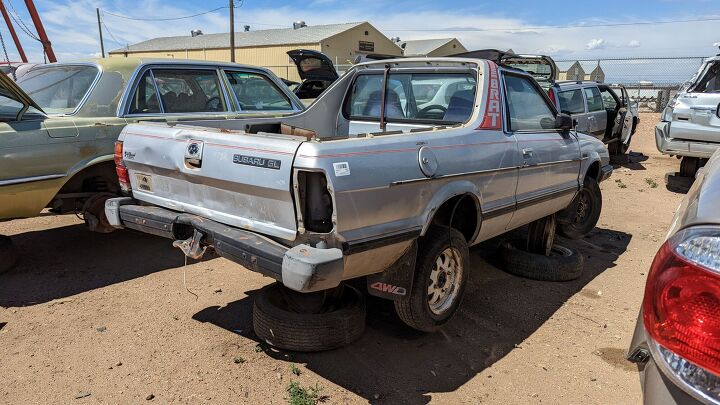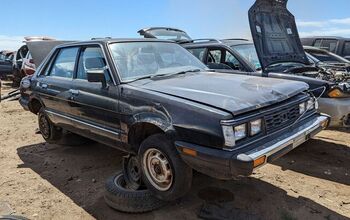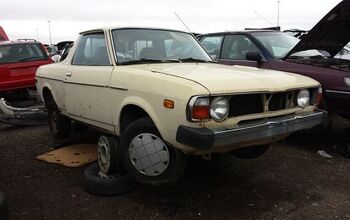Junkyard Find: 1986 Subaru BRAT GL

Subaru sold the Leone in the United States from 1972 through 1994, going through three generations in the process. It was available here in sedan, coupe, hatchback, and wagon form… and as a pickup known as the BRAT. Today's Junkyard Find is a second-generation BRAT, found in a self-service yard between Denver and Cheyenne.
Unlike the other versions of the Leone sold in North America, every BRAT had four-wheel-drive as standard equipment. This made it a sales hit in snowy, mountainous Colorado.
As recently as 10 years ago, I found so many discarded BRATs here that I didn't even bother photographing most of them.
Since that time, examples of the BRAT have become very rare here, in the junkyard or on the street.
Some rusted to death, but most just got used up.
This one was in pretty good condition when its career ended. It isn't rusty and the interior is worn but not horribly abused.
Just a bit over 150,000 miles on the odometer at the end. The highest-mile junkyard Subaru I've documented so far was a 1993 Impreza with 319,554 miles.
This is a high-zoot Brat GL with plenty of nice features and options. US-market Subaru Leone-based car models in 1986 were just called "The Subaru" and so their trim levels became de facto model names here.
In order to evade the 25 percent Chicken Tax on imported light trucks, Subaru installed carpeting and jump seats in the beds of 1978-1985 BRATs sold here. This made them cars in the eyes of federal law. It was one of the more clever methods of Chicken Tax avoidance, but lawsuits resulting from injured back-seat passengers in these "cars" ended up costing Subaru plenty.
1986 was the first model year for the jump seat-free BRAT.
As we can see from the underhood emissions sticker, this is a 49-state (non-California) vehicle and it was categorized as a light truck by the federal government.
At first glance, I thought the shaky-looking graphics were a backyard-applied attempt to imitate the optional factory-applied decals.
However, closer examination shows that 37 years of exposure to the elements simply blew out the edges of the lettering. By the way, BRAT stands for Bi-Drive Recreational All-Terrain Transporter. Not quite as good a tortured Japanese-English acronym as Nissan's PLASMA (Powerful and Economic Light Accurate Silent Mighty Advanced) or Sun Creative System's WOOZ (Wild and Original Object with Zoom), but respectable.
It appears that this truck began its career in Bristol, Pennsylvania, just across the Delaware River from New Jersey.
This oil-change sticker shows that it was still in Pennsylvania in 1993. The lack of rust probably indicates a relocation to the west soon after.
The engine is a 1.8-liter boxer four, rated at 73 horsepower and 94 pound-feet when new.
The transmission is the base four-on-the-floor manual. BRATs were never offered here with five-speed manuals, though a three-speed automatic was an option. I've only found one slushbox-equipped BRAT in all my junkyard travels.
This truck has true four-wheel-drive, with a lever the driver had to yank to switch to front-wheel-drive for use on dry pavement. Subaru began selling vehicles here with what we'd now call all-wheel-drive during the late 1980s; every U.S.-market new Subaru came with AWD starting with the 1996 model year.
This truck has the optional T-top roof, pitched as the "Twin-Halo" roof by Subaru.
It also has the no-extra-cost factory four-speaker AM/FM radio, which was necessary for listening to the top hits of the era in proper fashion.
There's air conditioning, which the 1986 Edmund's Foreign Car Prices book claims was standard equipment in the 1986 BRAT GL (I'm skeptical).
From the front, it looks nearly identical to the GL sedan of a couple of years earlier.
The MSRP for this truck before options was $7,783, or about $21,667 in 2023 dollars.
The final model year for the BRAT in the United States was 1987. Sales elsewhere continued through 1994. Subaru tried to revive the old BRAT magic with the Legacy-based Baja for the 2003-2006 model years, but sales weren't great.
"Just tell 'em it saves ya money, bustah!"
This commercial for the early BRAT emphasizes the fun jump seats.
In Australia and New Zealand, it was known as the Brumby.
[Images: The Author]
Become a TTAC insider. Get the latest news, features, TTAC takes, and everything else that gets to the truth about cars first by subscribing to our newsletter.

Murilee Martin is the pen name of Phil Greden, a writer who has lived in Minnesota, California, Georgia and (now) Colorado. He has toiled at copywriting, technical writing, junkmail writing, fiction writing and now automotive writing. He has owned many terrible vehicles and some good ones. He spends a great deal of time in self-service junkyards. These days, he writes for publications including Autoweek, Autoblog, Hagerty, The Truth About Cars and Capital One.
More by Murilee Martin
Latest Car Reviews
Read moreLatest Product Reviews
Read moreRecent Comments
- Tassos You can answer your own question for yourself, Tim, if you ask instead"Have Japanese (or Korean) Automakers Eaten Everyone's Lunch"?I am sure you can answer it without my help.
- Tassos WHile this IS a legitimate used car, unlike the vast majority of Tim's obsolete 30 and 40 year old pieces of junk, the price is ABSOLUTELY RIDICULOUS. It is not even a Hellcat. WHat are you paying for? The low miles? I wish it had DOUBLE the miles, which would guarantee it was regularly driven AND well maintained these 10 years, and they were easy highway miles, not damaging stop-go city miles!!!
- Tassos Silly and RIdiculous.The REAL Tassos.
- Lostboy If you can stay home when it's bad out in winter, then maybe your 3 season tire WILL be an "ALL-SEASON" tire as your just not going to get winters and make do? I guess tire rotations and alignments just because a whole lot more important!
- Mike My wife has a ‘20 Mazda3 w/the Premium Package; before that she had a ‘15 Mazda3 i GT; before THAT she had an ‘06 Mazda Tribute S V6, ie: Ford Escape with a Mazda-tuned suspension. (I’ve also had two Miata NAs, a ‘94 & a ‘97M, but that’s another story.) We’ve gotten excellent service out of them all. Her 2020, like the others before it, is our road trip car - gets 38mpg highway, it’s been from NC to Florida, Texas, Newfoundland, & many places in between. Comfortable, sporty, well-appointed, spacious, & reliable. Sure, we’d look at a Mazda hybrid, but not anytime soon.😎
























































Comments
Join the conversation
I always appreciated the Brat and believe that the time might be right to release a similar type of vehicle on the market. Back then there were a number of vehicles that could fall under the 'ute category including the Dodge Rampage/Plymouth Scamp which were Omni/Horizon derivatives.
I always liked these, though I don’t know how they got those seats in the bed past the feds. Safety considerations aside, the ride in those plastic outboard seats must have been bone-jarring. And I can’t imagine those handles flanking the seats helped much with comfort or safety.
An Impreza-based pickup might do well with outdoorsy types who would like a pick up bed for work or fun but don’t want or need a colossal, expensive truck. It would seat only 2, in the cab, of course.
What’s with that unpleasant troll, anyway.